| P-1 | |
|---|---|
 | |
| General information | |
| Type | Interceptor |
| Manufacturer | Sukhoi OKB |
| Status | Prototype only |
| Number built | 1 |
| History | |
| First flight | 12 July 1957 [1] |
The Sukhoi P-1 was a prototype Soviet interceptor.
| P-1 | |
|---|---|
 | |
| General information | |
| Type | Interceptor |
| Manufacturer | Sukhoi OKB |
| Status | Prototype only |
| Number built | 1 |
| History | |
| First flight | 12 July 1957 [1] |
The Sukhoi P-1 was a prototype Soviet interceptor.
Sukhoi began design studies for what was to become Izdeliye P in 1954 to meet an urgent request from the Ministry of Aviation Industry (MAP – Ministerstvo Aviatsionnoy Promyshlennosti – ministry of aviation industry). The early studies considered crew size, armament (missiles, cannon or both), and powerplant (with a choice of Lyulka AL-9 or AL-11, Klimov VK-9F, Kuznetsov P-2 or Kuznetsov P-4 engines). [1]
The P-1 was designed for the Uragan-1 (Hurricane-1) collision-course intercept radar, which was quite complex and bulky, requiring a crew of two and air intakes on either side of the fuselage rather than at the nose, retaining the delta wing of the Sukhoi T-3 with 57-degree leading edge sweep. Although the production aircraft was intended to use the Lyulka AL-9 engine, then in development, the prototype was fitted with a Lyulka AL-7F of lower power. [2]
The P-1 first flew in July 1957 but underwent only limited flight testing due to unavailability of the intended powerplant and ongoing problems with the radar and missile systems as well as lukewarm enthusiasm from the VVS (Voyenno-Vozdooshnyye Seely – Soviet air forces). OKB-51 persisted for some time trying to raise enthusiasm for the P-1 by proposing an even bigger engine, the Tumansky R-15-300 afterburning turbojet, with singular lack of success. The sole P-1 prototype was relegated to experimental work and later scrapped. [1]
A second prototype, the P-2 was studied, powered by twin Klimov VK-11 engines in the rear fuselage, but this version was cancelled at the mock-up review stage. [1]
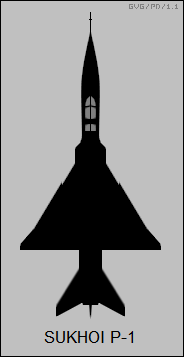
Data from Green, [2] Sukhoi Interceptors [1]
General characteristics
Performance
Armament
Avionics

The Sukhoi Su-7 is a swept wing, supersonic fighter aircraft developed by the Soviet Union in 1955. Originally, it was designed as a tactical, low-level dogfighter, but was not successful in this role. On the other hand, the soon-introduced Su-7B series became the main Soviet fighter-bomber and ground-attack aircraft of the 1960s. The Su-7 was rugged in its simplicity, but its Lyulka AL-7 engine had such high fuel consumption that it seriously limited the aircraft's payload, as even short-range missions required that at least two hardpoints be used to carry drop tanks rather than ordnance.
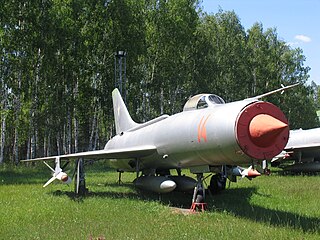
The Sukhoi Su-11 is an interceptor aircraft used by the Soviet Union during the Cold War.
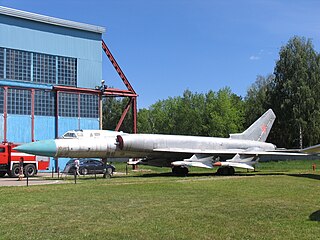
The Tupolev Tu-28 is a long-range interceptor aircraft introduced by the Soviet Union in the 1960s. The official designation was Tu-128, but this designation was less commonly used in the West. It was the largest and heaviest fighter ever in service.

The Sukhoi Su-9 is a single-engine, all-weather, missile-armed interceptor aircraft developed by the Soviet Union.

The Tupolev Tu-98 was a prototype swept wing jet bomber developed by Tupolev for the Soviet Union.

The Sukhoi Su-9 was an early jet fighter built in the Soviet Union shortly after World War II. The design began in 1944 and was intended to use Soviet-designed turbojet engines. The design was heavily influenced by captured German jet fighters and it was subsequently redesigned to use a Soviet copy of a German turbojet. The Su-9 was slower than competing Soviet aircraft and it was cancelled as a result. A modified version with different engines and a revised wing became the Su-11, but this did not enter production either. The Su-13 was a proposal to re-engine the aircraft with Soviet copies of the Rolls-Royce Derwent turbojet as well as to modify it for night fighting, but neither proposal was accepted.

The Yakovlev Yak-19 was a prototype Soviet fighter built in the late 1940s. It was the first Soviet aircraft to be equipped with an afterburning turbojet, the Klimov RD-10F that was derived from the German Jumo 004 engine. Only two examples were built as it was rejected for service by the Soviet Air Force.

The Lyulka AL-7 was a turbojet designed by Arkhip Mikhailovich Lyulka and produced by his Lyulka design bureau. The engine was produced between 1954 and 1970.
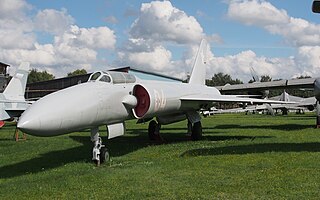
The Lavochkin La-250 "Anakonda" was a high-altitude interceptor aircraft prototype developed in the Soviet Union by the Lavochkin design bureau in the 1950s. Its nickname "Anaconda" was invented during the flight test and referred to both the elongated body shape as well as the relatively critical flight characteristics of the machine.
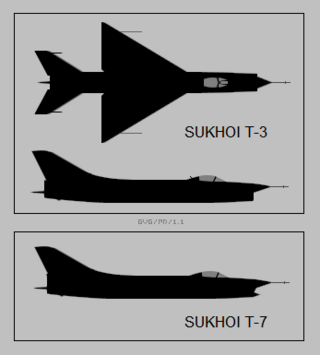
The Sukhoi T-3 was a prototype Soviet fighter aircraft.

Yakovlev Yak-50 was an early experimental turbojet interceptor aircraft designed in 1948 by the Yakovlev OKB in the USSR. The aircraft was essentially a stretched version of the Yakovlev Yak-30 (1948), with a more powerful engine and greater wing sweep. The Yak-50 is perhaps most significant as the first Yakovlev aircraft equipped with velosipednoye (bicycle) landing gear, a trademark of later Yakovlev designs. The Yak-50 designation was later reused for a propeller-driven aerobatic and trainer aircraft.

The Lavochkin La-200 was a two-seater, swept winged, night/all-weather jet prototype designed as an interceptor and manufactured by the Soviet Union's Lavochkin Design Bureau from 1948.
The Alekseyev I-212 was a twin-engine jet fighter designed in the USSR in 1947 at OKB-21. It was a two-seat variant of the I-21 designed in response to a requirement for a very long-range fighter issued by the Voenno-Vozdushnye Sily (VVS),, in 1946. Intended as an escort fighter, it was also designed for use as a night fighter and reconnaissance aircraft. No prototype was built, although some parts may have begun building before the project was completed.

The Yakovlev Yak-1000 was a Soviet supersonic technology demonstrator intended to evaluate the aerodynamic layout and field performance of the cropped delta wing discussed in captured German documents in combination with the new Lyulka AL-5 turbojet. The tandem undercarriage proved to be unsatisfactory and there were serious flight stability problems related to the delta wing, enough so that it never flew after an accident during taxiing tests.

The Yakovlev Yak-140 was a Soviet prototype lightweight supersonic fighter developed during the 1950s. The prototype was completed in 1954, but it was denied authorization to enter flight testing and the program was cancelled in 1956.
The Mikoyan-Gurevich I-75 was the final design of a series of three experimental swept-wing interceptors developed in the Soviet Union in the mid-late 1950s by the Mikoyan-Gurevich design bureau from their Mikoyan-Gurevich I-3 airframe. All the aircraft in the I-3 program were affected by delays in the development of the Klimov VK-3 turbojet engine, its cancellation and ultimate replacement by the Lyulka AL-7F turbojet engine.
The Mikoyan-Gurevich I-3 was the first of three interrelated fighter prototype programs developed by the Mikoyan-Gurevich design bureau in the Soviet Union in the mid/late 1950s – starting with the I-3, continuing with the I-7 and finally evolving into the I-75. On several occasions airframes were rebuilt and/or reused, both within a program or in a succeeding program. All the aircraft in the I-3 program were affected by delays in the development of the Klimov VK-3 afterburning bypass turbojet engine, and its cancellation and replacement by the Lyulka AL-7F turbojet engine.

The Mikoyan-Gurevich I-320 was a prototype Soviet long-range all-weather interceptor aircraft of the late 1940s-early 1950s. Only two were made, with no production following.
The Mikoyan-Gurevich I-7 was a development of the Mikoyan-Gurevich I-3 experimental fighter. Planned as a Mach 2-class aircraft, the I-7 was the second of a series of three experimental fighter aircraft from the Mikoyan-Gurevich design Bureau. Like the Mikoyan-Gurevich I-3, the I-7 was to be one of the components of the automated Uragan-1 then under development by protivovozdushnaya oborona strany, the Soviet defense system.
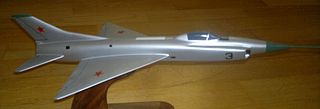
The Sukhoi T-49 was a prototype Soviet fighter aircraft.